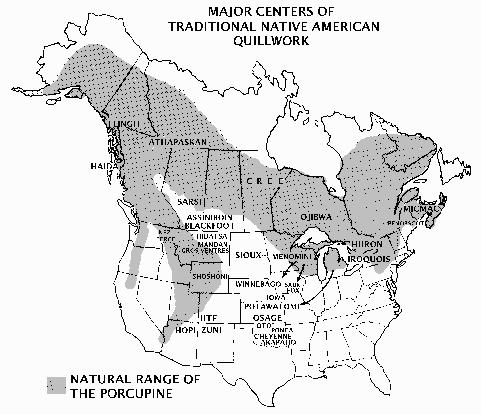
About Porcupines...
by Tara Prindle

The porcupine is a powerful rodent unique to North America; the only other place in the world where porcupines are found is in Africa, but that porcupine has enormous quills nearly a foot long and a 1/4 inch in diameter (not very suitable for quill embroidery decoration). The northern range of the common porcupine covers most of Canada, the western U.S., northern parts of New England and the Great Lakes region. Porcupines favor a wooded habitat, but some subspecies (7 in all) live in deserts and grasslands.
The porcupine is one of the largest rodents in North America, second only to the beaver, and porcupines grow to a length of 2 to 31/2 feet, tail included. They usually weigh between 8 and 14 pounds, although they have been known to weigh upwards of 35 pounds. The porcupine may live for 5 years or more in the wild, and in captivity they generally live a decade.
Although this quilled animal has several nicknames ('pricklepig' being my personal favorite), the latin name for the porcupine is Erethizon dorsatum ('to irritate with back') The Porcupine, with a body shape like other rodents, has over 30,000 quills on its body. Quills cover the back and sides of this animal, with stiffer fatter quills on its tail. There are no sharp quills on the porcupines nose, and the belly of this animal is vulnerable, covered only with stiff brown hairs. The color of the quills is white with brown or black tips, although the quills of western porcupines have yellowish colored tips.
Porcupines don't "throw" their quills; nor are they known to attack other animals. But, their quills are nature's best defense. The quills are loosely attached to the porcupine's body and an animal has to connect with the porcupine to be hit with the quills. If threatened, the porcupine raises its quills, looking like a giant pincushion. When attacked, the porcupine wields its tail back and forth pounding its quills into the adversary. The porcupine can imbed its quills almost an inch into opponents skin. Each quill has hundreds of quills have tiny barbs or hooks. Once embedded, these hooks cause the quill to work its way even deeper and they make removing set-in quills painful and difficult.
Unwary animals (birds of prey, domestic animals and even people) that have wound up with a mouth or throat full of quills often die of starvation or from infections caused by the germs on the quills. Like common hairs, new quills grow back to replace the ones shed by porcupines. Despite their natural defense, some predators (bobcats, cougars, coyotes and especially fishers) are able to hunt porcupines without injuring themselves, by rolling the rodent onto its back exposing its unprotected soft belly.
Porcupines are nocturnal and have poor vision but a very good sense of smell. Porcupines generally like to eat the evergreen tree inner bark and needles, but they do find some hardwoods palatable. They also eat aquatic plants, berries, seeds, flowers, nuts, and grasses. Salt is often sought after by porcupines and they've also been known to gnaw on antlers and bones for the calcium. During the day, porcupines can usually be found sleeping peacefully in the high crook of a tree, or like other rodents, taking care of their newborns in underground burrows. Because of the porcupine's eating habits, which often damages trees, weasels have been introduced in some regions to reduce porcupine populations. Fortunately some states, such as Maine, now have laws protecting porcupines.

|
Return to NativeTech's Main Porcupine Quillwork Menu

|
Text and Graphics
© 1994 - Tara Prindle unless otherwise cited. |